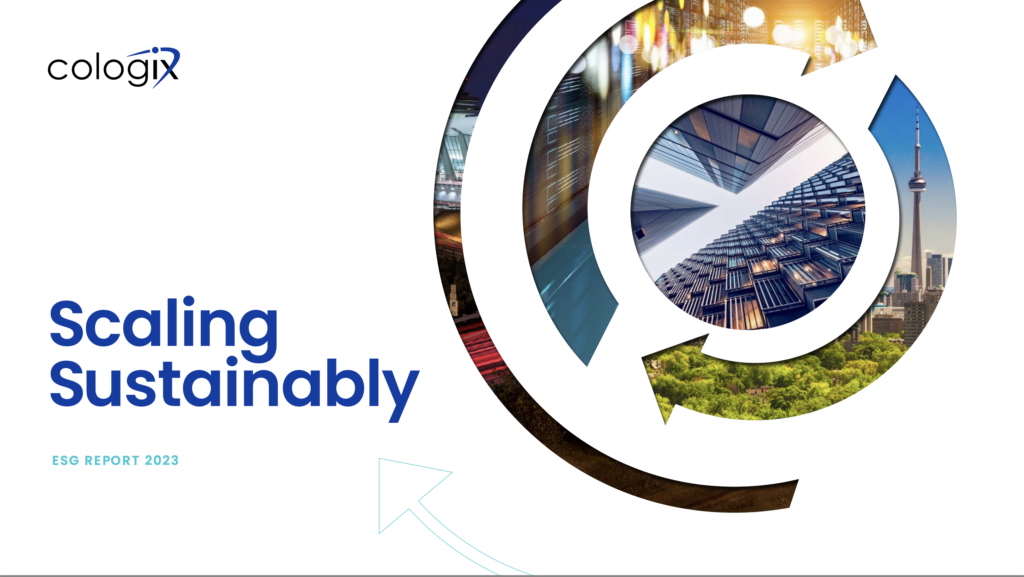In light of global climate change and the importance of reducing adverse human impact on the planet, businesses around the world are working to chart paths to carbon neutrality.
Even the most active companies in promoting environmental, social and corporate governance (ESG) understand that reducing reliance on fossil fuels and mitigating the emissions they create will take time. But as they work toward these lofty goals, businesses can do what they can now to reduce their overall impact.
Data centers are one source of particularly high energy consumption and carbon emissions. Since the internet has become central to our modern societal infrastructure, it has given rise to the need for data centers to transfer and store vast amounts of data around the world. While the benefits of the information highway to humans are innumerable, the data centers and data transmission networks the internet is built on also require an extremely high amount of energy to run.
Data centers account for as much as 1.5% of total global electricity use, which generates 3.5% of global greenhouse gas emissions (GHG) according to the International Energy Agency (IEA). Data center growth is also not slowing down, in fact quite the opposite. The demand for data centers in the U.S. alone is expected to grow by more than 10 percent each year through 2030, and will consume an estimated 35 gigawatts (GW) of power by 2030, compared to only 17 GW in 2022 according to McKinsey.
As data center businesses look to reduce their impact on the planet in alignment with their ESG goals, they must find ways to curb the energy use that their facilities utilize. Below we explore best practices in promoting ESG and reducing the impact of data centers around the world.
Keeping it Cool
More than half of power consumed in data center facilities is used by their cooling systems designed to regulate the facility at the appropriate temperature and humidity levels to ensure optimal operation of equipment. If a data center becomes too hot, it can lead to potentially severe consequences like equipment failure, service disruptions, reduced performance, risk of fire and IT equipment lifespan reduction. All of these factors can negatively impact the overall efficiency and responsiveness of the data center – underscoring the need to keep these facilities cool at all times. However, the problem is that the energy used to supply these cooling systems is beginning to take a toll on our natural world. So, the challenge then becomes reducing the energy a data center uses without opening the door to any of the consequences listed above
One creative way this is being done is by pioneering data centers with natural free-air cooling designs in colder climates throughout the northern US and Canada. Ambient outdoor air is often cooler than the air inside data centers and can be used to reduce dependence on mechanical cooling. Many data centers are now employing energy efficient fans that circulate outside air throughout the facility, in concert with HVAC controls that maintain an ideal temperature range to maximize the free air-cooling operating timeframe. If naturally cool weather can mitigate the need for energy, it not only reduces energy needs, but also makes the facilities more affordable to run.
In addition to these advancements in natural cooling systems, the integration of liquid cooling methods has become a leading solution in handling the growing requirements of heavy compute and AI applications. Liquid cooling involves immersing servers or computing components in dielectric fluid to draw heat away more efficiently than traditional air cooling systems. It not only aids in maintaining optimum temperatures but also reduces the energy required for cooling, thereby contributing to the overall sustainability goals of data centers. As companies aim to curb their reliance on fossil fuels, these advancements in cooling technologies, particularly through the integration of natural cooling methods and liquid cooling systems, signify pivotal steps toward more sustainable data center operations.
Resource Conservation
Another factor in reducing the global impact of data centers is more effectively conserving the resources that the facility utilizes other than energy. In defining, calculating and mitigating their environmental footprint, data center operators must also consider how it is using natural resources like water.
Water is a critical resource to data center technology, primarily for its use in cooling, so data center operators should work to minimize water usage and increase the use of reclaimed water whenever possible. The availability of water and its use within the facility should be one of the top considerations for data center businesses when constructing and designing the facility. One way that facilities can do this is to use closed-loop water systems that ensure they are recycling water and not returning it to the environment. They also can ensure their facilities adhere to allowable temperature and humidity ranges, which reduces the amount of water used for cooling and humidification and ensures an overall improvement in energy efficiency.
Facilities also should consider the types of waste and how much waste they are producing as a result of normal data center operations. If not already established, data centers can add recycling pickup to ensure cardboard, plastic, paper and aluminum are recycled appropriately. On top of normal trash and recycling, in the process of upgrading facilities with new technologies, most data centers often accumulate used hardware. Mitigating the amount of this used hardware that is simply thrown away through an electronic waste (eWaste) recycling program is another way to reduce the overall impact of the facility.
Smart Energy Usage
There are a number of sustainable design elements currently being built into data centers specifically for the purposes of making the facilities more environmentally friendly. Utilizing LED lighting for example, equipped with occupancy sensors and dimming options is one simple way to improve energy efficiency and reduce unnecessary expenditures in data center facilities.
Improving the processes by which the data center tests and monitors its generators is another way to directly reduce emissions from data centers. Generator backup power remains the fastest way to convey power to a data center when it’s shut off in the event of a natural disaster. While backup generators are critical to any data center’s function, testing those generators is a source of carbon emissions. By reducing generator testing frequency across facilities, data center owners can save energy while also ensuring generators remain available when they are necessary.
It’s important to remember that data center operations are inherently energy intensive.
Operations leaders should continuously search for opportunities to better manage their carbon footprint, increase efficiency and upgrade facilities with leading technologies that support energy reduction. One way to do this is to prioritize sustainability in data center builds by carefully measuring and reducing embodied carbon emissions throughout the construction process. Through collaboration with industry partners, operations leaders can select low-carbon materials and construction methods to minimize environmental impact.
In addition to reducing the amount of natural resources that data centers utilize today, data center managers should work to transition an energy purchasing program from fossil fuels to carbon free energy options from both renewable and nuclear energy sources.
As the data center industry and the technology infrastructure it supports continues to grow, data center businesses must keep the environmental footprint of the industry front of mind. It is our responsibility to manage and decrease the environmental footprint of our operations.
The next generation of industry-leading, mission critical data center facilities begin with excellent design. By considering the environmental impact of the construction process and rigorously maintaining the facility throughout its lifecycle, data center businesses can construct facilities built to last that deliver consistent, sustainable and high-quality services to their customers.
Data Center Sustainability FAQs
Q: What steps do take to ensure your data centers reduce their environmental impact?
A: Our data centers prioritize sustainability through various initiatives, including the use of energy-efficient cooling systems, adoption of renewable energy sources, and implementation of resource conservation measures.
Q: How do you address the challenge of energy consumption, particularly in cooling systems at your data centers?
A: We employ innovative cooling technologies such as natural free-air cooling designs and liquid cooling methods to minimize energy usage. These approaches utilize ambient outdoor air and dielectric fluid immersion to efficiently regulate temperatures, reducing our reliance on traditional, energy-intensive cooling systems.
Q: Could you provide details on how you manage water usage and waste disposal to minimize environmental impact at your data centers?
A: Our data center implements closed-loop water systems for cooling, recycling water within the facility to minimize consumption. We also prioritize waste management by recycling materials and partnering with electronic waste recycling programs to reduce our environmental footprint.
Q: What sustainable design elements are integrated into your data center infrastructure to enhance energy efficiency?
A: Our data center incorporates sustainable design elements such as LED lighting with occupancy sensors, dimming options, and efficient generator testing processes. These measures not only reduce energy expenditure but also contribute to overall environmental sustainability.
Q: Apart from renewable energy sources, what additional efforts do you undertake to mitigate environmental impact and promote sustainability in data centers?
A: In addition to transitioning to renewable energy, we collaborate with industry partners to select low-carbon materials and construction methods, adhere to environmental certifications and standards, and actively participate in broader sustainability initiatives within the data center industry.











